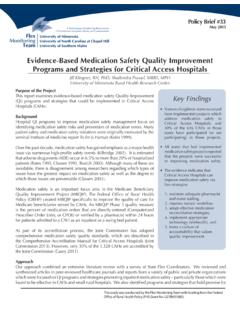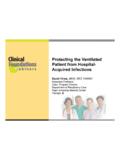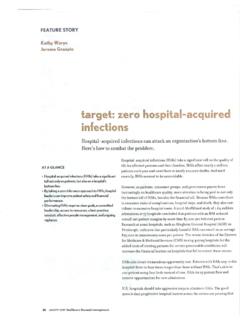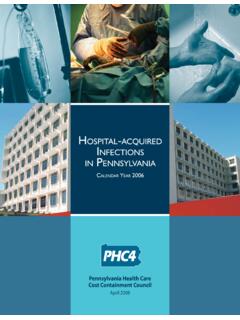Transcription of Reporting of Healthcare-Associated Infections by …
1 Flex Monitoring Team Policy Brief #39 September 2015. Reporting of Healthcare-Associated Infections by critical Access Hospitals Michelle Casey, MS; Emma Distel, BS; Alex Evenson, MA; Shailendra Prasad, MBBS, MPH; Peiyin Hung, MSPH. University of Minnesota Rural Health Research Cebter KEY FINDINGS. A review of state statutes and regulations indicates that 34 of the 45 Flex states require hospitals to report data to the state and/or the Centers for Disease Control and Prevention (CDC) National healthcare Safety Network (NHSN) on one or more healthcare associated Infections (HAIs).
2 In 12 of these 34 states, the HAI Reporting requirement only applies to Prospective Payment System (PPS) hospitals or to hospitals with Intensive Care Units (ICUs); specifically excludes critical Access Hospitals (CAHs) or low-volume hospitals; or includes a waiver or exemption process. Among the six HAIs reported to Hospital Compare via NHSN, CAHs were most likely to report data on CDI (283 CAHs, ) and MRSA (227 CAHs, 17%), followed by SSI for colon surgery (189. CAHs, ), SSI for hysterectomy (153 CAHs, ), and CLABSI and CAUTI (147 CAHs, 11%.)
3 Each). Although many CAHs do not have the minimum number of cases to calculate facility-level risk- standardized infection ratios, analysis of pooled data from groups of similar facilities can help track infection trends and identify potential targets for HAI prevention and quality improvement initiatives at the state level or among groups of CAHs providing similar services. INTRODUCTION The Centers for Medicare and Medicaid Services (CMS) require Prospective Payment System (PPS). Healthcare-Associated Infections (HAIs) in hos- hospitals to report data on six HAI measures: central pitals have garnered considerable attention in recent line- associated bloodstream Infections (CLABSI).
4 Years and are the focus of multiple national and state catheter- associated urinary tract infection (CAUTI);. Reporting requirements and prevention initiatives. An surgical site Infections (SSI) from colon surgery; SSI. estimated 5-10% of hospitalized patients experience a from abdominal hysterectomy; methicillin-resistant HAI every year, resulting in significant morbidity and staphylococcus aureus (MRSA) Infections ; and clos- HAI measures indicate how often patients tridium difficile (CDI) PPS hospitals re- in a hospital contract certain Infections during their port HAI data to the CDC NHSN, which shares the medical treatment.
5 These Infections can often be pre- data with CMS. CMS does not require CAHs to re- vented when healthcare facilities follow guidelines for port data on the HAI measures, but CAHs may choose safe care. to report on a voluntary basis. CDC reports that 404. A Performance Monitoring Resource for critical Access Hospitals, States, and Communities Flex Monitoring Team Policy Brief #39 | September 2015. Reporting of Healthcare-Associated Infections by critical Access Hospitals CAHs contributed data to NHSN in 2013, up from ral Health survey respondents each.
6 To resolve missing 324 CAHs in or conflicting information from the above sources, we Four HAI measures (CLABSI, CAUTI, CDI, and checked state health department websites, and analyzed MRSA) are optional patient-safety measures for the state statutes and regulations regarding HAI Reporting . Medicare Beneficiary Quality Improvement Project Next, we analyzed data for January 2013 through (MBQIP) in FY 2015-2017. State Flex Programs may December 2013 reported by CAHs on the six HAI. choose to assist CAHs in their states with Reporting measures in Hospital Compare (CLABSI; CAUTI.)
7 Data on these four measures and implementing quality SSI from colon surgery; SSI from abdominal hyster- improvement activities to improve patient outcomes on ectomy; MRSA blood Infections ; and CDIs). CAHs the that reported data on one or more procedures (the denominator for the SSI infection rates), patient days PURPOSE (the denominator for CDI and MRSA blood infection measures), or device days (the total number of days that The purpose of this policy brief is to describe state HAI all patients had a central line or urinary catheter, the Reporting requirements and the extent to which they denominator for the CLABSI and CAUTI measures).
8 Apply to CAHs, and analyze data reported by CAHs were counted as Reporting that measure. on publicly-reported HAI measures in Hospital Com- According to CDC, the minimum numbers needed pare. A second policy brief in this series will describe for calculating facility-specific Standardized Infection evidence-based programs and strategies for reducing Ratios (SIRs) are 1 expected event or 50 device days HAIs in CAHs. ,12 A SIR compares the number of Infections that occurred in a facility or a state to the number of DATA AND APPROACH Infections that were expected based on previous years of reported data.
9 Few CAHs have the minimum 50 device We used multiple approaches to identify state HAI re- days or 1 expected event for calculating SIRs at the in- porting requirements and the extent to which they ap- dividual hospital level. (For the last six months of 2013. ply to CAHs. We reviewed information on overall state and the first six months of 2014 Hospital Compare HAI Reporting requirements and state health care infec- data, the number of CAHs nationally with calculated tion plans from the CDC website6 and on state statutes SIRs was 0 for CLABSI and SSI-hysterectomy, 1 for and recent legislation regarding HAI Reporting from MRSA and SSI-colon surgery, 2 for CAUTI, and 170.)
10 The Association of State and Territorial Health Officials for CDI.). (ASTHO).7-11 Key contacts for the State Health Care No longitudinal data were publicly available to calcu- Infection Programs in the 45 Flex States were identi- late state-level expected events for the two SSIs, so we fied from the CDC website, and these individuals were analyzed performance for CLABSI, CAUTI, MRSA, surveyed via email about whether small rural hospitals and CDI. We followed CDC methods for calculating in their state (including CAHs) were required to report pooled mean infection rates for CAHs nationally and HAIs to the state and/or NHSN, and whether small ru- by state by summing the numerators for all CAHs with ral hospitals (including CAHs) were included in HAI data for each measure in each state and dividing it by the Reporting and prevention initiatives.













